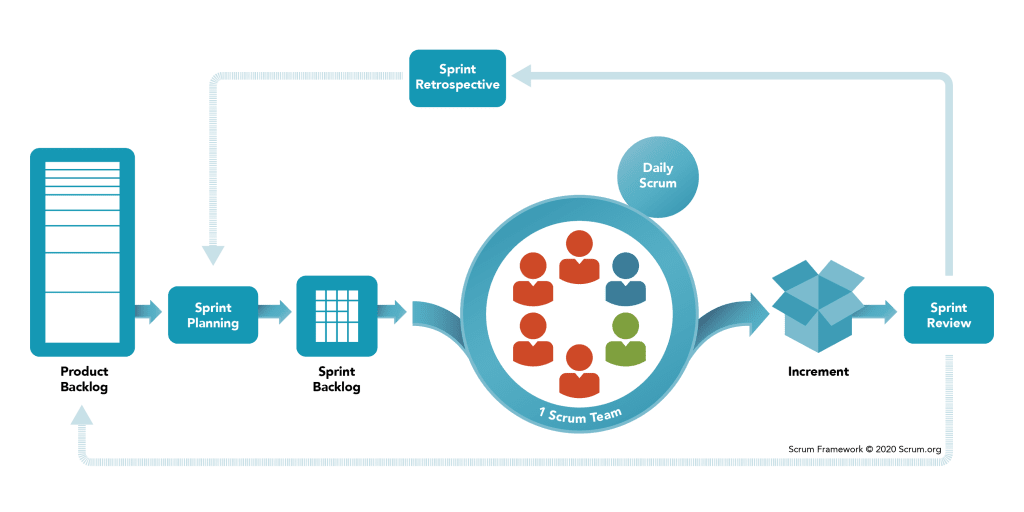
How to do the Home Scrum events
What are the Scrum events?
In Scrum, we avoid the term ‘meeting’ because even inside the corporate world, it has too many negative connotations. They used to be called ‘ceremonies’ but now they’re referred to by the simple ‘events.’ In short, these are:
- The Sprint Plan (deciding on the Sprint Goal, and therefore which tasks to bring in for the next sprint and which tasks to discard)
- The Sprint Review (at the end of the sprint, showing others what work you have done and seeing if you met the Sprint Goal)
- The Sprint Retrospective (a team-only event, to reflect on your ways of working, how it’s all going, and whether there are any changes in how you do things to try during the next sprint)
- The Daily Scrum (a fifteen-minute session with the whole Scrum team at a set time every day to let everyone know what you’ve been doing over the last day and what you intend to do over the coming day, as well as how the Sprint Goal is going)

In practice, there is usually a ‘sprint-end’ day when the team can do the Sprint Review, Sprint Retrospective and Sprint Planning events in one go. This is tiring, but combined with a team lunch in between, can feel quite rewarding.
All of these events are very useful in a Home Scrum setting, but in terms of being absolutely essential for a functional Home Scrum system, this is the order of importance:
- The Daily Scrum (without checking in every day, your Scrum board isn’t getting used and the whole system dies)
- The Sprint Retrospective (this allows the team to adapt the system to suit them, and also express emotions in a safe space so that frustrations don’t grow)
- The Sprint Plan (it does really, really help to get an overview of all your upcoming tasks and to decide on a pre-determined Sprint Goal, but at a pinch you can go along with capturing tasks that need doing on an ad hoc basis)
- The Sprint Review (this is designed for stakeholders to see an Increment towards the Product Goal, which doesn’t apply to Home Scrum, so it’s more about recognising your work from the sprint and celebrating if you’ve achieved your Sprint Goal)
Implementing Scrum is harder than it sounds
Scrum is a very simple framework to understand, but it is difficult to master. Why? Because Scrum is more than just physical things like a board and tickets. It hinges on the team participating in these regular Scrum events, and doing anything regularly and consistently, let alone in a way that keeps everyone genuinely engaged, is a huge challenge.
The Daily Scrum is, by far, the hardest to do, because it’s daily. If you only did one Scrum event, it should be the Daily Scrum. You would miss out on important things like having a Sprint Goal, but you would still be using your board and keeping your Home Scrum system active. It is at the heart of keeping the board and the system alive.
The Daily Scrum
Keep the Daily Scrum to fifteen minutes
The Daily Scrum has a set maximum time-box of fifteen minutes. That’s even for large teams with the maximum recommended size of ten people. It is set up to be the antithesis of long, boring meetings that go on for hours and go off on lots of tangents; it is simply the opportunity for the team to check in about what they have been doing and plan to do next. It is also the prime chance to check your Sprint Goal and see if you are making progress towards it, or if there are obstacles in the way.
For Francis and I, since there are only two of us, our Daily Scrums rarely last more than five minutes. However, at least to start with, you may want to set a timer of some sort to make sure yours fit into the allotted time.
One trick that became popular in Scrum teams in order to encourage keeping the Daily Scrum short and snappy is to have everyone on the team stand up during it (if they’re physically able to, of course). This is where the unofficial but common name of ‘the daily stand-up’ came from. If you’re standing up, you’re less likely to linger for longer than necessary.
Consider scheduling the Daily Scrum at a set time each day
In a work setting, the Daily Scrum always happens at the same time every day, and every team member is meant to make every effort to attend it. In Home Scrum, we’ve always struggled to stick to a fixed time, but we’ve always had our Daily Scrum in the evening (often last thing at night when we remember we haven’t done it yet). If you have more members of your family or team, you may need to agree a fixed time out of necessity so everyone can arrange themselves around it.
Even if you don’t stick to a fixed time, it could still be good to agree a time during your Daily Scrum for when you can do the Daily Scrum the next day, and set an alarm to remind you. Without this there is a danger that the Daily Scrum just gets forgotten.
The Sprint Retrospective
The Sprint Retrospective only happens once per sprint, so usually weekly or fortnightly. A ‘retro’ is an opportunity for the Scrum team to reflect on their existing Scrum system, so that they can come up with at least one small, experimental change. It allows the team to air emotions and grievances before resentment builds up. This is why it’s absolutely vital to your Home Scrum system to try and include retros along with Daily Scrums, even if you don’t have the space or energy to tackle full Sprint Plans or Sprint Reviews.
Purpose 1: to take stock of the team’s feelings
Having an official and regular chance for the team to talk to each other about how they’re feeling with their progress, the Home Scrum system, and life in general is a great opportunity for better mental health and communication both at work and at home. We have found that without doing regular Sprint Retrospectives, we argue more, about things which would have come up and been addressed in a retro, if we’d made time to have one. So, even if it’s just five minutes—don’t let it slip from the schedule.
Purpose 2: to come up with some tweaks to your system
The other purpose of a Sprint Retrospective is to come up with some ways you could potentially make your Home Scrum system work better for you. So: you take one thing that has been bothering the team and try and come up with ideas for ways to improve it. You then experimentally apply the idea for one sprint and discuss in the next retro whether the team liked it and whether to make your experiment part of your normal way of working. This fits with the Scrum (and agile) principle of ‘inspecting and adapting’.
The Sprint Plan
Sprint Planning is where the team decides which Sprint Goal to focus on during the next sprint, and therefore which tasks to bring in. Officially, a sprint is closed off from adding any new tasks once the planning is done, so choosing which things and how much to attempt is a tricky process. Trying to figure out what to aim for in life is a huge challenge in itself, so don’t worry if it takes a while to figure out how to get the most out of your Sprint Planning; doing any amount of looking ahead will help to make sure you’re not caught off-guard by upcoming obligations.
You may also need to use some time during your Sprint Planning to refine your existing tasks to be a clearer set of steps towards your ultimate outcome. Refining tasks in the backlog is supposed to be an ongoing part of the Scrum system, with every member of the team allowing a bit of time per sprint to address questions and figure out how exactly a task can be addressed. At work, we have weekly ‘backlog refinement’ sessions booked in to do exactly this. At home, rather than add an extra event to fit in, we combine this with our Sprint Plan. There are more tips about how to break down tasks and recognise stale ones.
The Sprint Review
The Sprint Review is the final Scrum event that you can integrate into your Home Scrum system if you want to. In a business setting, its purpose is to present the next Product Increment to any stakeholders of that product. (The stakeholders are supposed to be quite hands-off the rest of the time to allow the Scrum team to work out how they will get things done in their own way, so in return they get these regular chances to see how it’s going and give feedback so that the product can be inspected and plans can be adapted accordingly.)
Of course, when doing Home Scrum there aren’t really any stakeholders outside of the household to present to, so the Sprint Review has a bit less purpose. However, there are two functions of the review to consider replicating. Firstly, a Sprint Review lets you celebrate what you’ve accomplished. It is very important to look back on what you’ve achieved and focus on the positives, as our brains are evolutionarily wired to give a lot of weight to negative events. Secondly, Sprint Reviews are useful in Home Scrum to provide tangible motivation for achieving the sprint goal. If you never review the results of your sprint, it’s easy to let sprint goals slip.
Celebrate what you’ve achieved
Technically, a ‘done’ column on your Scrum board isn’t truly necessary, especially if you’re not even counting up story points at the end of the day. As soon as a task is done you could just take the ticket straight off the board and put it into the recycling.
However, we like having both a ‘done’ column (to count up at the end of the day) and a ‘done-done’ column, where the finished tasks (which are not regulars) can gather until we’re ready for a Sprint Review. (Usually only once every couple of months for us, rather than every sprint.) Then we empty the ‘done-done’ column, making sure to read out each task as we take them off. It is astonishing how much more we’ve always done than I remember doing. It really helps to remind myself of this, because then I realise that perhaps we are a bit more on top of things than I realised, and I am proud of us and feel a bit more confident about the future.
We have in fact recently reinstated this practice, because even though I knew it was important, we weren’t doing this for several months. Just like if you skip Sprint Retrospectives and then feel a build-up of tension from not clearing the air, I found that not having a Sprint Review to at least take a moment to acknowledge our achievements was slowly wearing me down.
Potentially keep the good tasks in a Jar of Awesome
A final idea for your Sprint Review would be to keep a ‘Jar of Awesome’. For us, this is a small wooden box where we keep our favourite completed tickets to remember more long-term. Then occasionally when we need a boost we can open it and look through some of the highlights we’ve managed to achieve.







